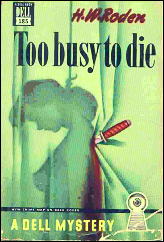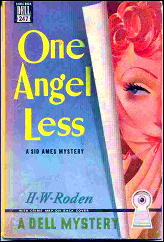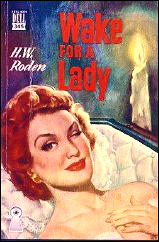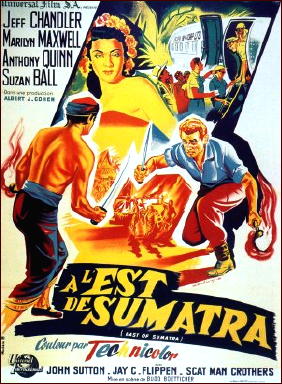February 2010
Monthly Archive
Thu 25 Feb 2010

DRACULA, PRINCE OF DARKNESS. Seven Arts / Hammer Films, 1966. Christopher Lee, Barbara Shelley, Andrew Keir, Francis Matthews, Suzan Farmer, Charles Tingwell, Thorley Walters, Philip Latham. Screenwriter: Jimmy Sangster. Director: Terence Fisher.
Although there were, I believe, other Dracula films in between, Prince of Darkness is the one that’s a direct sequel to The Horror of Dracula (1958), also with Christopher Lee as Count Dracula, and one of the films that put Hammer Films on the map.
The means by which Dracula is brought back to life is one of the key scenes in this second movie, and so while I of course will say no more about it, it is (no surprise) rather a gruesome one. There are two scenes which caused a shiver down my back, and one of them is the one that occurs soon afterward, as an unwary character in the story stumbles across the scene.
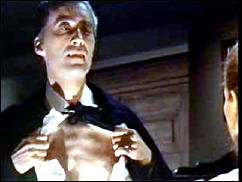
And Dracula’s first appearance in the flesh (so to speak) was the other. Christopher Lee doesn’t get a lot a screen time himself, surprisingly enough, and no dialogue (only hissing, I believe), but seeing him quietly appear in the shadows as he does for the first time is enough to make anyone jump.
Unfortunately, this is also one of movies in which the participants are warned, and explicitly so by the no-nonsense Father Sandor (Andrew Keir), to stay away from the castle, but do they listen? You needn’t ask. So that I found disappointing, and after his grand plan to rescue himself from oblivion succeeds in such fine fashion (and in this I am not exaggerating), he seems to flail around rather ineffectively thereafter.
As a vampire hunter, Father Sandor is both a realist in terms of the evil he’s facing as well as an implacable foe, and I think this makes Andrew Keir, a giant of a man himself, the star of the movie.
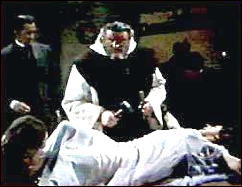
Following immediately after the events chronicled in Prince of Darkness came Dracula Has Risen From The Grave (1968), a movie I saw about a year or so ago. For some reason, I do not seem to have written a review of it, but I recall it as having more plot to it than this one.
This one, though, most reviewers seem to regard as a classic. It’s good but not that good, if you were to ask me, and there is of course no reason that you should. If you’re a fan of horror films, you’ll have seen this one already, and you’ll already have formed your own opinion.
Thu 25 Feb 2010
REVIEWED BY WALTER ALBERT:
PAID TO LOVE. Fox, 1927. George O’Brien, Virginia Valli, J. Farrell MacDonald, William Powell, Thomas Jefferson, Hank Mann. Photography: L. William O’Connell; director: Howard Hawks. Shown at Cinecon 45, Hollywood CA, September 2009.

J. Farrell MacDonald, an American banker, travels to a small Balkan kingdom for the purpose of making a financial investment to shore up the country’s faltering economy.
He becomes chummy with the king (Thomas Jefferson) and they plot to marry off Crown Prince Michael (O’Brien), who seems unwilling to settle down.
Their bait is Gaby, a cabaret dancer (beautiful Virginia Valli), but the machinations of Michael’s cousin (William Powell) threaten to thwart the pair’s plans and break up the budding relationship.
Hawks was quoted in the program notes by his biographer (Todd McCarthy) as saying that he was influenced by German Expressionist director F. W. Murnau in his tracking shots, lighting and editing.
It’s certainly an elegant, stylish film, with the expected polished performance by Powell, engaging characterizations by MacDonald and Jefferson, and an attractive portrayal of the developing romance by the forthright O’Brien and sultry Valli.
Thu 25 Feb 2010
THE BACKWARD REVIEWER
William F. Deeck
H. W. RODEN – You Only Hang Once. William Morrow, hardcover, 1944. Hardcover reprint: Detective Book Club, 3-in-1 edition, April 1944. Paperback: Dell #104, mapback edition, 1945.
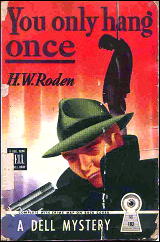
Another case here for the lack of talents of Sid Ames, private eye. When Johnny Knight, public-relations man, finds a dead lawyer in his office, he calls on Ames.
Things don’t work out too well with Ames in charge. Later, when Ames and Knight are at a gambling joint where peril looms, Ames proceeds to get drunk and pass out.
At a meeting with most of the suspects in the lawyer’s murder, Ames gets a message from his office, which his secretary tells to the butler so all can hear. Just in case the possible murderer might have missed something or been slow on the uptake, Knight, a runner-up to Ames in stupidity, reveals that the message was from the deceased lawyer’s paramour. Ames and Knight then deliberately dawdle before going to see the woman. Imagine their surprise to find that someone has strangled her.
The novel would be funny if it were only humorous.
— From The MYSTERY FANcier, Vol. 13, No. 3, Summer 1992.
Bibliographic information: [Expanded from the Revised Crime Fiction IV, by Allen J. Hubin] —
RODEN, H(enry) W(isdom). 1895-1963. JK= Johnny Knight, SA = Sid Ames.
You Only Hang Once (n.) Morrow 1944. Dell #104. JK, SA
Too Busy to Die (n.) Morrow 1944. Dell #185. JK, SA
One Angel Less (n.) Morrow 1945. Dell #247. SA
Wake for a Lady (n.) Morrow 1946. Dell #345. JK, SA
Wed 24 Feb 2010
A TV Review by MIKE TOONEY:
“That Time in Havana.” An episode of Kraft Suspense Theatre (Season 2, Episode 14). First air date: 11 February 1965. Steve Forrest, Dana Wynter, Victor Jory, Frank Silvera, Val Avery. Teleplay: William Wood. Story: Irving Gaynor Neiman. Director: Alex March.
It’s been six years since Castro’s revolution took over Cuba. An American woman, Anne Palmer (Dana Wynter), has come to Havana to plead for her husband, who has been imprisoned for being a spy against Fidel. But El Jefe won’t see her, and she’s forced to deal with a lower-level functionary, Colonel Velasquez (Val Avery), who seems only to want to molest her. She gets nowhere.
Until she meets Mike Taggart (Steve Forrest), a journalist; with him she’s able to turn up some unpleasant facts about her husband, including that million dollars her husband was trying to retrieve for the Mob when he was arrested. It seems Anne didn’t know the man she married as well as she thought she did…
Despite the title, “That Time in Havana” isn’t a light-hearted caper film, although it could have been played that way, from which it would have greatly benefited. It mostly reminds me of two Humphrey Bogart films: Casablanca (1942) and To Have and Have Not (1944).
In both of those, Bogie spends a lot of time being — or pretending to be — uninvolved with the political turmoil swirling around him; similarly, Dana Wynter’s character cares only about her husband’s plight and is indifferent to politics until she has to make a decision near the end of the story that has political ramifications.
He-man actor Steve Forrest has had a long career. Criminous credits include: Phantom of the Rue Morgue (1954), Rogue Cop (1954), three episodes of The Name of the Game (1969-70), four episodes of Gunsmoke, 36 episodes of S.W.A.T. (1975-76), 15 episodes of Dallas (1986), five appearances on Murder, She Wrote, and 3 on Team Knight Rider (1997-98).
Dana Wynter has the distinction of appearing in one episode of the Colonel March of Scotland Yard TV series (1956, under her German birth name, Dagmar Wynter), the sci-fi thriller Invasion of the Body Snatchers (1956), The List of Adrian Messenger (1963), one episode of The Wild Wild West (1966), a regular role in the nearly-forgotten spy series The Man Who Never Was (18 episodes, 1966-67), five episodes of The F.B.I., three appearances on Cannon (1973-75), and as Mrs. Ironside in the TV movie The Return of Ironside(1993).
Wed 24 Feb 2010
A MOVIE REVIEW BY DAVID L. VINEYARD:
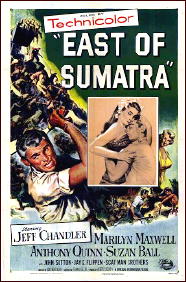
EAST OF SUMATRA. Universal, 1954. Jeff Chandler, Marilyn Maxwell, Anthony Quinn, Suzan Ball, John Sutton, J.C. Flippen, Peter Graves, Scat Man Crothers, James Craven. Screenplay: Frank Gill Jr., based on a story co-authored by Louis L’Amour. Director: Budd Boetticher.
Here’s a well done pulp-style jungle adventure from action director Budd Boetticher and based on a story by western writer king Louis L’Amour.
Jeff Chandler is a two-fisted mining engineer whose team is sent to the Maylayan jungle to find tin and runs afoul of local royal Quinn who is jealous of his half caste fiance’s (Ball) interest in Jeff. An added complication is Chandler’s officious boss John Sutton, who is engaged to marry Marilyn Maxwell, Jeff’s ex girl.
Things go wrong, and soon Chandler and team are held virtual prisoner by Quinn and his men,and their only means of escape is by hand-to-hand combat to the death in a native temple between Chandler and Quinn.
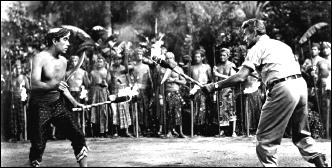
Attractively filmed by Boetticher, East of Sumatra is a mix of adventure pulp and Men’s Sweat Mag brought to life (“I Fought a Sumatran King for His Woman and a Fortune in Tin”).
The characters are familiar stereotypes — Chandler the two-fisted boss; Flippen the older veteran straw boss; Graves a Texan engineer in ten gallon hat; Crothers the singing camp cook; Quinn the proud jealous native king; Sutton the boss that doesn’t understand the real world of the field men; Maxwell the bad girl trying to forget her past and rough tough Chandler; Suzan Ball a sultry half white princess torn between jungle king Quinn and handsome westerner Chandler…
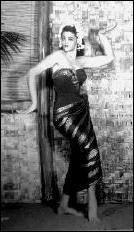
Technicolor, well done jungle sets, some nice matte paintings, a good if predictable script, and a competent cast of veterans show how well this sort of thing could be done in the right hands.
Nothing great, but a showcase of old fashioned studio competence done neatly and with a bit of flare, and the battle between Chandler and Quinn is well matched and handled in a circle of torchlight.
These kinds of films used to be a staple in theaters. Minor A films churned out by competent directors and featuring attractive casts who hit their marks and generally were better than the material.
It’s the sort of thing Hollywood relegated to television eventually but is seldom done as well today, and if it isn’t art, it is at least entertainment and done with some style.
Editorial Comments: That’s Suzan Ball in the dancing girl costume in the photo just above. She was a second cousin of Lucille Ball who had the sad misfortune of dying young, at the age of 21, a victim of cancer. Married to actor Richard Long when she died, she appeared in only eight films and one episode of Lux Video Theater before her death.
On another matter, both David and I have been trying to learn whether the story this movie was based ever appeared in printed form, with no definitive answer so far. We presume the answer is no, but does anyone know for sure?
Wed 24 Feb 2010
A REVIEW BY WALKER MARTIN:
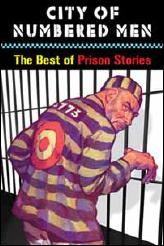
JOHN LOCKE, Editor – City of Numbered Men: The Best of Prison Stories.
Off-Trail Publications, trade paperback; 1st printing, January 2010.
Back in the 1960’s and 1970’s it was actually possible to find and build up extensive collections of many rare pulp titles. Most readers and collectors were aware of only the SF pulps (and pulps which printed early SF like Argosy and All Story), and the hero pulps like The Shadow, Doc Savage, G-8, The Spider, etc.
There wasn’t a lot of competition for other pulps back then, and I managed to find many of the Harold Hersey magazines not many other collectors were looking for — magazines such as Ace-High, Cowboy Stories, Danger Trail, and of course one of the most fascinating titles, Prison Stories.
Now of course it is very hard indeed to find such rare pulps as Danger Trail and Prison Stories. But we are fortunately living in the age of print on demand reprint collections. Now within a matter of weeks, it is possible to publish a collection of pulp stories with all sorts of interesting editorial comments in the form of original research articles.
Another example of this trend is a new book which I have just received in the mail from John Locke, publisher of Off-Trail Publications, a pulp reprint line of books. The title is City of Numbered Man: The Best of Prison Stories. It is a very handsome large paperbound volume of 274 pages, priced at $20.00.
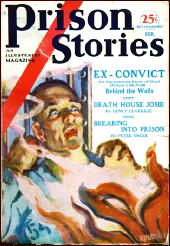
You may order it from amazon.com, Adventure House, or Mike Chomko Books. It also is available from John Locke directly using Paypal by contacting directly at offtrail@redshift. com.
The book consists of 12 stories reprinted from Prison Stories, all dating from 1930 to 1931, including a long novelet “Big House Boomerang.” These stories alone would make the collection a must buy, but there also is a 15 page article about the history of the magazine entitled “Imprisoned Pulp,” by John Locke.
John has also included a 34 page biography, “Harold Hersey: Tales of an Ink-Stained Wretch,” and in addition, we have 7 pages of notes on the authors, an index, and 20 pages of letters from ex-cons and lovers of prison fiction, reprinted from the crumbling pages of the magazine itself.
I repeat, if you are a lover of pulp fiction, then this is a must have volume. John Locke has done around 20 of these reprint books and we need to show our support so that he will continue this worthy cause. This book gets my highest recommendation.
Tue 23 Feb 2010
FIRST YOU READ, THEN YOU WRITE
by Francis M. Nevins
This column isn’t my usual hodgepodge but sticks to one subject and therefore deserves a title. How about “Call for Campion Complete”?
A few months ago and for no particular reason I decided to read the first series of Margery Allingham’s short stories about Albert Campion in the order of their original publication as far as that could be determined.
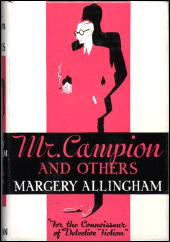
After some research on my own shelves and in The FictionMags Index, which is by far the leading Web source when it comes to identifying where almost any work of short fiction in English first appeared, I identified 18 tales that clearly belonged on my reading list: two dating from 1936 or earlier, fifteen that appeared in The Strand Magazine between late 1936 and 1940, and a singleton first published in a London newspaper shortly before the outbreak of World War II.
There are also two short-shorts that present bibliographic as well as criminous puzzles but let’s save them for a while, shall we?
Revisiting the Easy Eighteen between 70 and 80 years later, I found them by and large to be as clever, charming and delightful as I remembered them from decades ago. Most of the crimes in these stories are jewel thefts or con games, with hardly a murder anywhere but plenty of indications in the later tales that England is moving ever closer to that form of mass murder we call war.
“The Man with the Sack” (The Strand, December 1936) is a light-hearted Christmas story in which Campion frustrates a jewel scam while attending a holiday party at one of those stately homes of England that abound in Golden Age crime fiction.
Two years later, during the last peacetime Christmas season, came “The Case Is Altered” (The Strand, December 1938), where the setting is yet another holiday party at yet another stately home, but this time the McGuffin is a secret document revealing the country’s plans to purchase huge numbers of war planes.
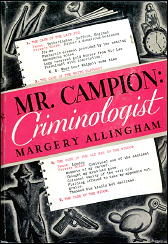
The next Campion tale in The Strand and for my money one of the weakest is “The Meaning of the Act,” an international espionage trifle which came out in the issue of September 1939, the month Hitler invaded Poland.
The eighteenth and last story in the batch is “A Matter of Form” (The Strand, May 1940). This one centers around a magnificent con game which could only have been devised during the so-called phony war, a time of “children in uniform and bankers in mourning” but with minimal disruption of ordinary life, so that Campion can still enjoy an oyster appetizer in the heart of a London soon to be blitzed.
The two stories that predate the fifteen in The Strand and a third from near the end of the cycle need to be treated separately.
“The Border-Line Case” is shorter than any Strand tale and, unlike any other Campion exploit, has a first-person narrator, namely Allingham herself. A careless reading of the story might suggest that she was cohabiting with her character, but then one notices a few subtle hints that besides the narrator and Campion and Detective Inspector Stanislaus Oates, there is a fourth and silent person in the room, presumably P. Youngman Carter, to whom Allingham had been married since 1927.
My guess is that this neat little impossible-crime story dates from between 1933 and 1935, making it Campion’s first short exploit.
“The Pro and the Con” is the same length as the Campion stories in The Strand but doesn’t seem to have appeared there. In this tale we find Campion bound, gagged and beaten up by an Edgar Wallace-style gangster, and that fact alone suggests a date slightly earlier than the Strand fifteen.
“The Dog Day” first appeared in the London Daily Mail sometime in June 1939, probably having been rejected by The Strand because of its complete crimelessness.
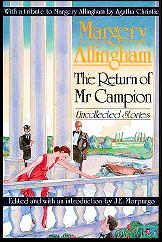
So much for the eighteen Campion tales that definitely belong on my reading list. Now we come to those two pesky short-shorts, each limited to a single scene and just one or two characters if you don’t count Campion and Scotland Yard’s Stanislaus Oates and the corpse.
The earlier of the pair to appear in the U.S. was “The Unseen Door” (Mystery Book Magazine, August 1946), which takes place in the billiards room of a London club. No concrete detail hints that the story might have been published in England ten or more years earlier and therefore belongs in the first series.
My hunch that it does stems from the other short-short, “Mr. Campion’s Lucky Day” (Ellery Queen’s Mystery Magazine, April 1947). Judging from his introduction, founding editor Fred Dannay thought Allingham had just written the tale. In the EQMM version Oates is given the rank of Superintendent, which he first sported in “The Old Man in the Window” (The Strand, October 1936). But when this tale finally appeared in a collection (The Allingham Minibus, 1973), Oates’ title is Detective Chief Inspector!
This strikes me as highly persuasive evidence that the story first appeared in England before October 1936. And is it plausible that two Campion short-shorts with as much in common as this one and “The Unseen Door” could have been written more than ten years apart? My tentative conclusion is that both are early entries in the Campion saga. Perhaps someday we’ll know for sure.
While immersed in my Allingham project I came upon a curious connection between one of these tales and perhaps the most powerful of all English noir novels, Graham Greene’s Brighton Rock (1938).
The sociopaths from the lower depths whose leader is the sexually terrified young racetrack racketeer Pinkie refer to women in several terms like “buers” which I’ve never seen elsewhere. But the Greene character who calls a young woman a “polony” has his counterpart in Allingham’s “The Meaning of the Act,” where a lower-class pickpocket uses the same word, although she (or perhaps her Strand editor) spells it “palone.”
To anyone eager for more about this obscure contribution to English slang: Google the word in either spelling and you will be enlightened.
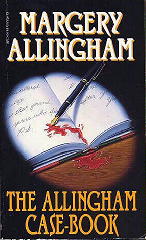
Even reading the fifteen Campion stories from The Strand requires more work than one might think. Besides needing to be at home in FictionMags Index, and assuming you don’t own copies of the magazine from the second half of the 1930s, you must have access to most of the Allingham collections published over the past 70-odd years.
The second edition of Mr. Campion and Others (Penguin, 1950) contains twelve of the fifteen, although chaotically out of order. But the 1936 Christmas story “The Man with the Sack” was collected only in Mr. Campion: Criminologist (1937) and The Allingham Minibus (1973), and its analogue from two Christmases later, “The Case Is Altered,” remained uncollected until The Return of Mr. Campion (1989).
That volume is also the sole hardcover source for the crimeless but charming “The Dog Day.” “The Border-Line Case” and “The Pro and the Con” were collected in both Mr. Campion: Criminologist (1937) and The Allingham Case-Book (1969), with “Border-Line” also appearing in the first edition of Mr. Campion and Others (1939) but not the second (1950).
Those pesky short-shorts “The Unseen Door” and “Mr. Campion’s Lucky Day” remained uncollected until the Minibus started to roll.
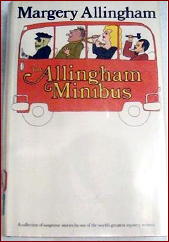
Then there’s one final problem. If you set out to read the Campion stories in order of first publication, as I did, you wind up having to save one of the earliest for last.
How can this be? Because of “The Black Tent,” which Allingham clearly wrote around 1936 but then put aside and rewrote as “The Definite Article” (The Strand, October 1937). The first version remained unpublished until almost a quarter century after her death, when it was included in a British anthology (Ladykillers: Crime Stories by Women, 1987) and then in the most recent Allingham collection to date, The Return of Mr. Campion (1989).
What a mess! Wouldn’t it be loverly if someday all the Campion shorts were brought together in their proper order in a single book?
NOTE: Previously on this blog: A Review by Mike Tooney: MARGERY ALLINGHAM – Mr Campion and Others.
[UPDATE] 02-25-10. I [Steve] posted this last question asked by Mike on the Yahoo Golden Age of Detection group. That it was a good idea, everyone agreed at once. Others wondered if other authors might also be honored with Complete Short Story collections, including (and especially) Edward D. Hoch. Here’s a reply from Doug Greene, head man at Crippen & Landru, which he’s graciously allowed me to reproduce here:
I fear that a complete collection of the Campion shot stories would make a hefty volume, but I’d love to see it done. C&L, however, specializes in books of uncollected short stories — though we made an exception of C. Daly King’s The Complete Curious Mr. Tarrant, which added 4 or 5 previously uncollected stories to the original 1935 volume.
The agent for Lillian de la Torre would like us to collect all of her Dr. Sam: Johnson stories into a single book — including 5 or so uncollected tales, but again the volume would be very long, and pricey to publish.
On the Hoch suggestion, Ed wrote almost 1000 short stories, which would fill about 66 volumes of the usual C&L size. We’ve already published 6 Hoch collections and have plans for at least 3 more… depending on energy and cash flow.
Our latest, Michael Innes’ Appleby Talks About Crime, is now in print, and we’re sending out copies to our subscribers as quickly as possible — especially since I leave for England in about a week (and will stay 10 days). After I return, we’ll take orders from the general public. And to answer an unspoken query, all the stories are previously uncollected.
Doug G
Then this response, also first appearing as a post on the Yahoo GAD group:
Barry Pike, chairman of the Margery Allingham Society, has been trying for a while to persuade Vintage, the UK publishers, to do this, but he doesn’t seem to be getting very far.
Lesley
—
Lesley Simpson
http://www.margeryallingham.org.uk
In spite of some less than entirely optimistic answers, thank you both, gentlemen!
Steve
Tue 23 Feb 2010
Posted by Steve under
Reviews[12] Comments
A REVIEW BY CURT J. EVANS:
JONATHAN LATIMER – The Lady in the Morgue. Doubleday Crime Club, hardcover, 1936. Paperback reprints include: Pocket Books #246, 1943; Dell, Great Mystery Library, 1957; International Polygonics, 1988. Film: Universal, 1938, with Preston Foster as PI Bill Crane.
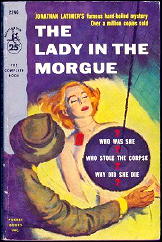
With its suggestions of necrophilia and glimpses of female bondage and nudity, as well as explicit racism on the part of the “sympathetic” characters, torture, grave-robbing and non-stop drinking, Jonathan Latimer’s The Lady in the Morgue is a rather spicy and unpleasant mystery tale for 1936 (or any other year, really!).
I find it interesting that the explicit depiction of sex acts between LIVE people was verboten, but frank discussion about the physical allurements of female corpses evidently made the grade!
Latimer is often paired with Craig Rice as a “zany” hardboiled writer of the period, but I would say Rice is the more simply zany of the two, while Latimer is much more hardboiled.
The humor in this novel is black indeed, having been filtered, surely, through earlier works like William Faulkner’s Sanctuary. The lead detectives are an exceedingly callous group of individuals. There is also an unpleasant racist edge in their treatment of blacks, Filipinos and Italians (though I have to admit the “game” played in the morgue had its lurid fascination).
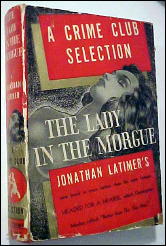
Certainly this novel is a long way from modern “political correctness” (I doubt for that matter that it was politically correct in 1936).
Buried in all this sensation is a quite solid mystery plot, one that would be at home in a classic British tale, revolving around a female suicide’s corpse stolen from the city morgue that becomes the target of interest of the cops, the detectives, a snobbish old-money family and two rival gangsters.
If you can stomach all the grand guignol stuff, you should enjoy The Lady in the Morgue for its undeniable inventiveness. And if you enjoy very spicy narratives you have a definite barnburner on your hands!
Editorial Comment: For a long insightful essay by John Fraser on Jonathan Latimer and his mystery fiction, plus a complete bibliography compiled by myself, go here on the main Mystery*File website.
Mon 22 Feb 2010
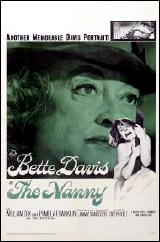
THE NANNY. Seven Arts/Hammer Films, 1965. Bette Davis, Wendy Craig, Jill Bennett, James Villiers, William Dix, Pamela Franklin. Screenwriter: Jimmy Sangster, based on the novel by Evelyn Piper. Director: Seth Holt.
Most of the reviews that I’ve glanced at so far have been fairly consistent about one thing, and that’s their telling their readers exactly what the movie’s about, in as much detail as you could ask, if you’d like to know what’s happening and what’s going to happen every step along the way.
I’ll do my best not to duplicate their efforts, but I have to admit that with… Well, I’m not going to say what I was just going to say.
When the movie begins, Bill and Virgie Fane (James Villiers & Wendy Craig) are about to welcome home their ten-year-old son Joey (William Dix) from where he’s been for the past two years — a children’s psychiatric institution, from all appearances — a suspicion that quickly proves to be correct.
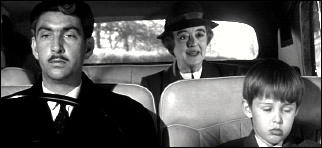
Even though Joey is about to be released, the head of the facility has his doubts. The boy is still very much prone to playing with nooses and pretending to hang himself in his room, but home he goes. Outwardly he appears to be normal, but he will have nothing to do with the family’s nanny (Bette Davis), for example, no matter how cheerful and understanding she tries to be.

It is Joey’s mother who needs the nanny, however, a longtime fixture in her family, not Joey. We (the viewer) gradually learn that there had been a tragedy in the family, one that involved Joey’s younger sister, who’s no longer alive.
What happened? And who was responsible? Those are the questions that have to be answered, and answered they are, but if you play the game (and don’t listen to people who want nothing more than to tell you the answer) you’ll be guessing for most of the movie.
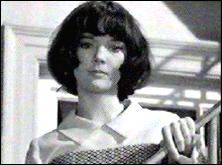
For the most part, this movie is little more than a battle of wits between Joey and Nanny, the only person siding with Joey being Bobbie Medman, the precocious and rather world-wise 14-year-old girl who lives in the apartment upstairs, played by 15-year-old Pamela Franklin. (Precocious in the sense that she has a boy friend and smokes cigarettes on the sly.)
While all of the acting is of high caliber, I was most impressed by the performances turned in by William Dix and Pamela Franklin. Without them in their respective roles, this movie could have been dull, duller and dullest. Dix also had a part in Doctor Dolittle (1967), but essentially nothing more. Pamela Franklin had a much lengthier career, mostly on TV, but earlier on made some horror movies and had, for example, a significant role in The Prime of Miss Jean Brodie (1969).
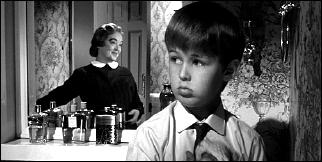
The Nanny, made in black and white, and correctly so, I believe, is a psychological thriller, and not the horror movie you might think it is, produced by Hammer Films as it was, and from the general tone of its advertising campaign. It’s not difficult to find on DVD, and in my opinion, well worth your time in watching. I enjoyed it, in any case, if you were still wondering.
Mon 22 Feb 2010
SARA PARETSKY – Deadlock. Dial Press, hardcover, 1984. Paperback reprints include: Ballantine, 1984 (shown); Dell, 1992.
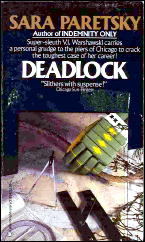
If I had the hardcover First Edition of this book, the second adventure of PI V. I. Warshawski, I imagine it’d be worth a fortune. (I might have had a review copy at one time, but if I did, it’s gone now. Easy come, easy go.)
Vic finds the murderer of her cousin Boom Boom, the hockey player, in this one. Injured and out of the game, Boom Boom had stumbled across some funny things going on in the Great Lakes grain-shipping business, his new career, and then he met what everybody else has called a fatal accident.
Vic’s investigation is as boring as most PI work probably is. It’s a tribute to Paretsky’ s writing ability that the case she cracks didn’t put me immediately to sleep. Grain-shipping is not the most fascinating topic in the world.
A lot of deaths take place in this book, some incidental, some intentional. Coming from Michigan originally myself, I appreciated the big blowup at the Soo Locks more than someone who hasn’t, I imagine. (That’s a lovely pun built into the title, by the way!)
This is not a puzzle type of a mystery, when it comes down to it. The killer(s) are reasonably obvious — it’s just getting the goods on him/her/them that’s the hard part.
– This review first appeared in
Deadly Pleasures, Vol. 1, No. 2, Summer 1993 (very slightly revised).
[UPDATE] 02-22-10. All in all, I believe I overestimated the long-run value of this book as a First Edition. Of course, I can blame it on the Internet, which has flattened the value of many books which would otherwise be considered hard-to-find and valuable, if only there weren’t dozens of copies available and easily found. In “Very Good” condition, a First Edition copy of Deadlock can be obtained for $40, while one in “Fine” shape might set you back $65.
Nothing to retire on, in other words.
« Previous Page — Next Page »





